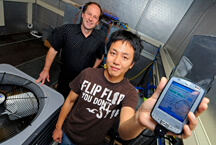
| RELATED INFO |
| * James Braun |

June 22, 2009
Energy-saving method checks refrigerant level in air conditioners
WEST LAFAYETTE, Ind. - |
Engineers have developed a technique that saves energy and servicing costs by indicating when air conditioners are low on refrigerant, preventing the units from working overtime.
The new "virtual refrigerant charge sensor" is particularly practical for automotive air conditioners, which tend to leak refrigerant more than other types of units, and also for household central air conditioning units, said James Braun, a professor of mechanical engineering.
Maintaining the proper "charge," or amount of refrigerant in a system, saves energy because air conditioners low on refrigerant must operate longer to achieve the same degree of cooling as properly charged units.
"Not only does the energy efficiency go down, but you also reduce the lifetime of the unit because it has to work harder, causing parts to wear out faster," Braun said. "It's also very time consuming and costly to have a technician check the refrigerant and charge it up to specification. To accurately learn how much charge is in the system, you have to remove all of the refrigerant and weigh it, a procedure that requires a vacuum pump and is quite time consuming."
The new alternative works by using sensors to monitor the temperature of refrigerant at various points along the tubing in an air-conditioning unit. The technique is easy to use because the sensors are simply attached to the outside of the tubing, Braun said.
Researchers tested the system on various types of air conditioners running on conventional refrigerants, including R-22 and the more environmentally friendly R-410A, which is replacing R-22 in the latest units. The research has been funded by the California Energy Commission through its Public Interest Energy Research, or PIER, program.
Findings are detailed in a research paper presented June 22 during a meeting of the American Society of Heating, Refrigerating and Air Conditioning Engineers in Louisville, Ky. The technique also was described in a paper published in the journal HVAC&R Research. The paper was written by Braun and former mechanical engineering doctoral student Haorong Li, who is now an assistant professor of architectural engineering at the University of Nebraska.
Another research project at Purdue is nearing completion and has involved a more extensive evaluation of the virtual charge sensor. The project, also funded through California's PIER program, has been led by graduate student Woohyun Kim.
Purdue has applied for a patent on the technique, developed in research based at the university's Ray W. Herrick Laboratories.
Li and Braun created a software algorithm that interprets temperature-sensor data to estimate the amount of refrigerant in the system. The four sensors are attached to tubing running into and out of components called heat exchangers.
In air conditioning and refrigeration systems, liquid refrigerant evaporates in a heat exchanger called an evaporator, cooling the air. The refrigerant vapor turns back into a liquid in another heat exchanger called a condenser. During these evaporation and condensing steps, the refrigerant undergoes dramatic temperature changes.
Automotive air conditioning units equipped with the new refrigerant-charge system could activate a warning light on a car's dashboard. Technicians servicing home air conditioners might simply plug a personal digital assistant into the unit to read the refrigerant-charge information, Braun said.
Researchers began developing the technique four years ago.
"The method could be commercialized if a company invested some time in the implementation side," Braun said.
Writer: Emil Venere, 765-494-4709, venere@purdue.edu
Source: James Braun, 765-494-9157, jbraun@purdue.edu
Purdue News Service: (765) 494-2096; purduenews@purdue.edu
Note to Journalists: Note here for any information that is necessary for media.
PHOTO CAPTION:
Purdue mechanical engineering graduate student Woohyun Kim, at right, and James Braun, a professor of mechanical engineering, use a new technique designed to save energy and servicing costs by indicating when air conditioners are low on refrigerant, preventing the units from working overtime. Technicians servicing home air conditioners might simply plug a personal digital assistant into the unit to read the refrigerant-charge information. The conventional method for accurately learning how much charge is in a system involves removing all of the refrigerant and weighing it, a time-consuming procedure that requires a vacuum pump. (Purdue University photo/Andrew Hancock)
A publication-quality photo is available at https://www.purdue.edu/uns/images/+2009/braun-aircondition.jpg
Development, Evaluation, and Demonstration of a Virtual Refrigerant Charge Sensor
Haorong Li, PhD James E. Braun, PhD
Proper refrigerant charge level is critical for vapor-compression cycle refrigeration systems to operate efficiently and safely. The current practice of accurately determining charge levels is very time consuming and costly. Technicians must stop and evacuate the system, weigh the removed charge, and add the correct amount of charge to the system using a scale. This paper presents a method for obtaining accurate estimates of refrigerant charge level using noninvasive temperature measurements obtained while the system is operating. The method could be used as part of a permanently installed control or monitoring system to indicate charge level and/or to automatically detect and diagnose low or high levels of refrigerant charge. It could also be used as a stand-alone tool by technicians to determine existing charge and during the process of adjusting the refrigerant charge. The accuracy of the virtual refrigerant charge sensor is evaluated using laboratory data for seven different systems and over a wide range of operating conditions with and without the presence of other faults. The evaluation and demonstration verify that the virtual refrigerant charge level gauge has very good performance in terms of accuracy and robustness and can be easily implemented and installed in terms of both hardware and software.
To the News Service home page
